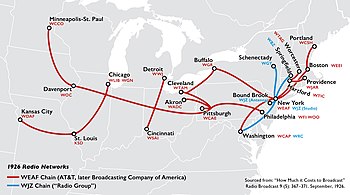Broadcasting Company of America
AT&T had an early interest in radiotelephone development, although initially only as a method for establishing telephone links to locations where it was not possible to string wire lines.
These agreements in effect assigned dominance in specified areas of the radio industry to individual participating companies, which eventually would meet with anti-trust challenges.
In addition, conflicting interpretations of some of the pact's clauses by the signatories would lead to numerous disputes, especially between AT&T and the other participants, known collectively as "the radio group".
[5] AT&T moved quickly to start implementation of its bold plan, and on February 11, 1922, formally announced its intention to develop a "national chain of radio transmitting stations".
[7] A more ambitious three-month link began operation on July 1, 1923, when Colonel Edward H. R. Green arranged for AT&T to provide WEAF's programming for rebroadcast by his station, WMAF in South Dartmouth, Massachusetts.
[7] Reacting to AT&T's actions, RCA quickly began efforts to establish its own network, originating from its New York City station, WJZ, but was badly handicapped in competing effectively.
RCA also investigated using high-powered or shortwave stations to establish network connections, but none of these alternatives matched the quality of AT&T's telephone links.
Unpublicized at the time were ongoing intense negotiations between AT&T and the radio group companies, led by RCA, about the status of the cross-licensing agreements, and the overall future of the broadcasting industry.
During BCA's short existence, the standard WEAF chain configuration consisted of 17 stations, concentrated in the northeastern United States, but also extending westward to WDAF in Kansas City.
"[15] WCAP in Washington, which had been sharing time on the same frequency as RCA's station WRC, was now considered redundant, and ceased operating as of August 1.
